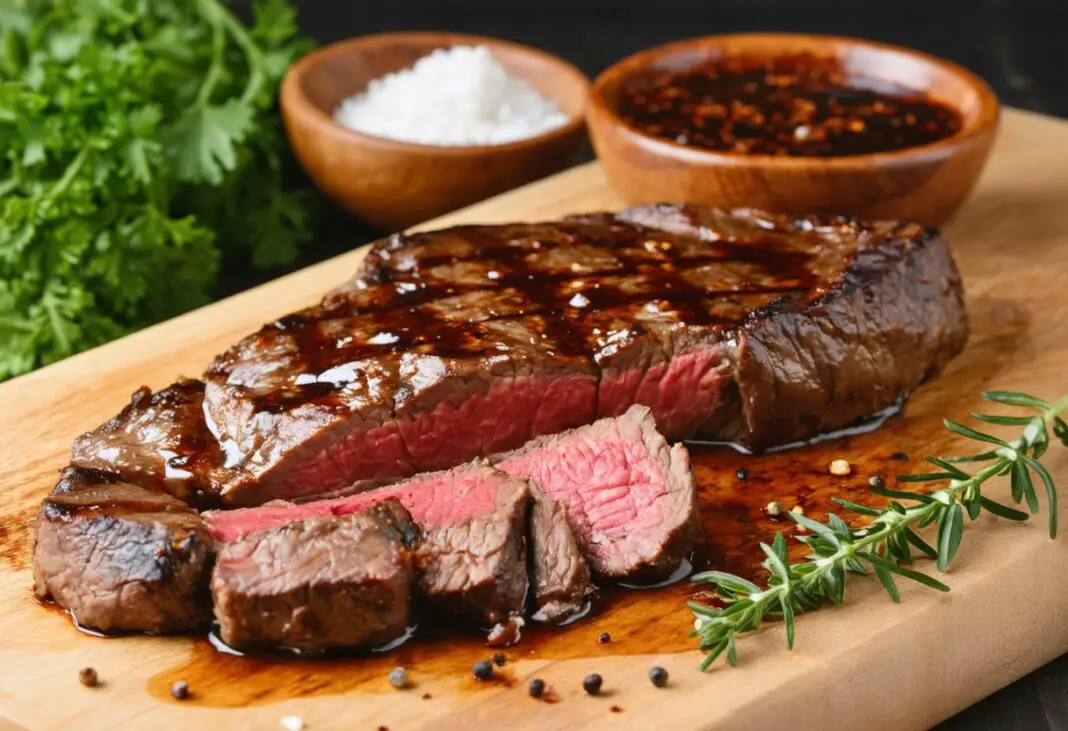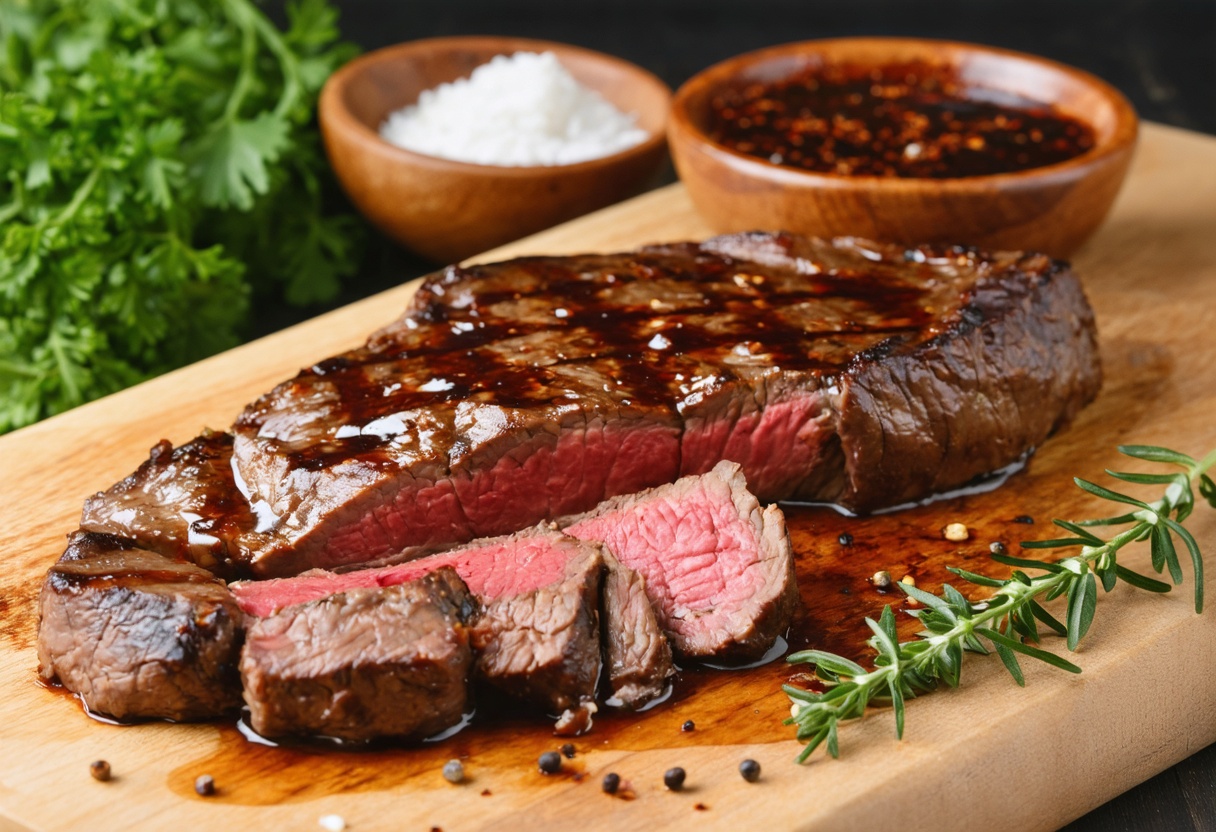Ever stood in your kitchen staring at a pack of steaks, wondering how restaurants make theirs taste so much better than anything that comes off your grill? The secret isn’t some fancy equipment or expensive cuts of meat. It’s actually sitting right in your pantry, waiting to transform even the most basic steak into something that’ll have your family asking for seconds. Just three everyday ingredients can create a marinade that’ll make your neighbors wonder what magic happened on your grill tonight.
Why three ingredients work better than complicated recipes
Most people think amazing steak marinades need a shopping list longer than their arm. The truth is, too many ingredients actually fight against each other, creating muddy taste instead of the bold, clean enhancement that makes steak shine. When a marinade has fifteen different spices and sauces, none of them get to do their job properly. It’s like having too many people talking at once – nobody gets heard clearly.
The magic happens when each ingredient has a specific job and room to do it well. Simple marinades let the natural beef taste come through while adding just enough extra punch to make every bite memorable. Professional chefs understand this principle – they build layers of complementary elements rather than throwing everything together and hoping for the best.
Soy sauce brings the umami punch
Soy sauce might seem like an odd choice for steak, but it’s actually a secret weapon that adds that mysterious “something extra” restaurants achieve. The fermented soybeans create natural glutamates – the same compounds that make mushrooms, aged cheese, and tomatoes so satisfying. This isn’t about making your steak taste Asian; it’s about amplifying the meaty, savory notes that make great beef so appealing in the first place.
Low-sodium versions work best because they let other elements shine without overwhelming everything with salt. The darker color also helps create that beautiful caramelization when the steak hits the grill. Three tablespoons is the sweet spot – enough to enhance without masking the beef’s natural character. Regular soy sauce works fine too, just remember it’ll make the final result saltier overall.
Worcestershire sauce adds complex depth
This British condiment packs an incredible amount of complexity into every drop. Made with anchovies, tamarind, vinegar, molasses, and spices, Worcestershire brings both acid and sweetness while adding layers that would take dozens of individual ingredients to recreate. The acid component helps break down tough muscle fibers, making even cheaper cuts more tender. The sweetness balances the saltiness and helps with browning.
The beauty of Worcestershire is how it disappears into the background while making everything else taste more like itself. One and a half tablespoons provides just enough acidity to tenderize without turning the surface mushy. Some people substitute balsamic vinegar here, which works well but creates a slightly different profile with more pronounced sweetness and tang.
Dijon mustard ties everything together
Mustard might sound weird in steak marinade, but it’s actually doing several important jobs at once. The tiny mustard seeds act as natural emulsifiers, helping all the liquid ingredients cling to the meat instead of sliding off. The slight heat adds interest without overwhelming, while the acidity contributes to tenderizing. French chefs have been using mustard with beef for centuries because the combination just works.
Dijon specifically works better than yellow mustard because it’s smoother and less aggressive. One tablespoon creates the perfect balance – noticeable but not overwhelming. The mustard also helps create an incredible crust when the steak cooks, contributing to those beautiful grill marks that make steaks look as good as they taste.
Timing matters more than most people realize
The biggest mistake people make with steak marinades is either not waiting long enough or waiting too long. Less than two hours means the marinade barely penetrates the surface – it’s basically just seasoning the outside. But more than 24 hours starts breaking down the meat structure too much, creating a mushy texture that no amount of perfect grilling can fix.
The sweet spot runs between four and 24 hours, depending on the cut thickness and personal preference. Overnight marinating usually produces the best results – long enough for real penetration but not so long that texture suffers. Thicker cuts can handle longer times, while thin steaks like skirt or flank reach their peak enhancement faster.
Which cuts benefit most from this treatment
While this marinade works on any steak, it absolutely transforms tougher, more affordable cuts into something special. Flank steak, skirt steak, and sirloin benefit enormously because the acids help break down connective tissue while the other ingredients add richness these leaner cuts sometimes lack. Even round steaks, often considered too tough for grilling, become completely manageable after a good soak.
Premium cuts like ribeye, filet mignon, and New York strip also taste fantastic with this marinade, though they don’t need the tenderizing help. The enhancement adds another dimension to already tender steaks without masking their natural characteristics. For special occasions, marinated premium cuts create restaurant-quality results at home.
Storage and safety tips that actually matter
Ziplock bags work better than dishes for marinating because they use less marinade while ensuring complete coverage. The plastic conforms to the meat shape, eliminating air pockets and guaranteeing even distribution. Always marinate in the refrigerator – countertop marinating creates perfect conditions for bacterial growth. Turn the bag occasionally if possible, though it’s not absolutely necessary.
Never reuse marinade that’s touched raw meat, no matter how tempting it seems. The risk isn’t worth it. However, unused marinade stores well in the refrigerator for up to three days in an airtight container. Making extra batches ahead of time means weeknight steaks become much more manageable when life gets busy.
Simple variations that change everything
Once this basic formula becomes second nature, small tweaks create completely different experiences. Adding a tablespoon of brown sugar and some fresh ginger transforms it into a teriyaki-style marinade perfect for rice bowls. A squeeze of lime and some Cajun seasoning takes it in a completely different direction. These aren’t different recipes – they’re simple modifications of the same solid foundation.
Swapping balsamic vinegar for the Worcestershire creates a sweeter, more Italian-inspired profile. Fresh herbs like rosemary or thyme add aromatic complexity without overwhelming the base combination. The key is making one change at a time so each modification can be evaluated properly before making it a permanent addition.
Cooking methods that maximize the marinade
Grilling produces the most dramatic results because the sugars in the marinade caramelize beautifully over direct heat. Medium-high heat works best – hot enough for good searing but not so hot that the outside burns before the inside cooks. The marinade helps create those coveted grill marks while keeping the interior juicy. Cast iron pans work almost as well indoors, providing the high heat needed for proper caramelization.
Always let marinated steaks come to room temperature before cooking – about 20-30 minutes on the counter. Cold steaks cook unevenly, with overcooked edges and undercooked centers. Pat steaks dry before cooking to ensure proper searing. The marinade will have done its job by then; surface moisture just creates steam instead of the beautiful crust everyone wants.
Sometimes the simplest solutions create the most impressive results. This three-ingredient marinade proves that great cooking isn’t about complexity – it’s about understanding how different elements work together. Next time steaks go on sale, grab a few extra and let this simple mixture work its magic. The difference will be obvious from the first bite.
Three-Ingredient Steak Marinade
Course: Main CourseCuisine: American4
servings5
minutes4
minutes55
kcalTransform any cut of steak with this incredibly simple marinade that uses just three pantry staples to create restaurant-quality results.
Ingredients
3 tablespoons low-sodium soy sauce
1½ tablespoons Worcestershire sauce
1 tablespoon Dijon mustard
Directions
- Combine all marinade ingredients in a small bowl. Whisk the soy sauce, Worcestershire sauce, and Dijon mustard together until completely blended and smooth. The mixture should be well incorporated with no visible streaks of mustard.
- Place your steaks in a large ziplock bag or shallow dish. Pour the marinade over the steaks, ensuring all surfaces are coated. If using a bag, seal it and gently massage to distribute the marinade evenly around the meat.
- Refrigerate the marinating steaks for at least 2 hours, though 4-24 hours produces the best results. Turn the steaks occasionally if possible to ensure even marination. Never exceed 24 hours as the meat texture may become too soft.
- Remove steaks from refrigerator 20-30 minutes before cooking to bring to room temperature. This ensures more even cooking throughout the meat. Pat the surface dry with paper towels to promote better searing.
- Cook steaks using your preferred method – grilling, pan-searing, or broiling. The marinade will help create beautiful caramelization and enhanced flavor. Allow steaks to rest for 5 minutes after cooking before slicing and serving.
Notes
- This recipe makes enough marinade for 1 pound of steak – double the recipe for larger quantities
- Never reuse marinade that has been in contact with raw meat for food safety reasons
- For best results, use this marinade on tougher cuts like flank steak, skirt steak, or sirloin
- Leftover unused marinade can be stored in the refrigerator for up to 3 days in an airtight container
Frequently asked questions
Q: Can I use regular soy sauce instead of low-sodium?
A: Yes, regular soy sauce works fine, but the final result will be saltier. You might want to reduce any additional salt you’d normally add to the steaks after marinating to avoid oversalting.
Q: What if I don’t have Dijon mustard?
A: Yellow mustard can substitute, though use slightly less since it’s more acidic. Whole grain mustard also works well and adds interesting texture to the marinade.
Q: Is two hours really enough marinating time?
A: Two hours is the minimum for noticeable results, but 4-8 hours produces much better penetration and tenderizing. Overnight marinating typically gives the best overall results.
Q: Can I freeze steaks in this marinade?
A: Absolutely! Freezing actually helps the marinade penetrate as ice crystals break down muscle fibers. Just thaw completely in the refrigerator before cooking for food safety.


